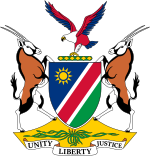Delimitation Commission of Namibia
| Delimitation Commission of Namibia | |
|---|---|
|
State companies , ministries and institutions in Namibia |
|
| Designation: | Delimitation Commission of Namibia |
| State level: | authority |
| Founding: | 1991 |
| Highest office: | Chairman |
| Officials: | Alfred Siboleka |
| Headquarters: | Windhoek |
The Delimitation Commission of Namibia (in German roughly (Territory) Delimitation Commission of Namibia ) is an authority in Namibia that is responsible for decisions on geographical delimitation. It is based in Windhoek. The independent institution deals exclusively with the division of Namibia in terms of constituencies and regions .
On the basis of Paragraph 103 of the Constitution of Namibia (officially the Boundaries Delimitation and Demarcation Commission ), the commission can be set up at the request of the President. Details are set out in the Local Councils Act, 1992 and the Local Authorities Amendment Act, 1997 . A high-ranking judge holds the presidency.
The geographical delimitation within Namibia is mainly based on the number of the population of voting age. In addition, geographical features, infrastructure, natural resources and the distribution of the existing local government are taken into account.
4. Demarcation Commission
The 4th delimitation commission was set up in January 2013. Judge Alfred Siboleka , chief judge at the Namibian High Court , held this office when he was appointed chairman by President Hifikepunye Pohamba . Other members are Zedekia Ngavirue (former chairman of the education council) and the general statistician of Namibia, John Steytler .
The commission was required to prepare its recommendations for change by June 2013. The urgency was highlighted by President Pohamba, as the redistribution of constituencies was crucial for voter registration, which must take place every 10 years under the electoral law. This in turn was necessary for the upcoming presidential and parliamentary elections in 2014 .
Proposals to the Commission
Proposals submitted to the commission by the regional and local administrations include the division of the Oshikoto and Kavango regions into two regions each, as well as the division of constituencies, including the Mpungu constituency . In addition, a region with the same name between the regions of Ohangwena, Oshana and Kavango was proposed by the Ondonga ethnic group . The proposal met with great opposition due to tribalism . In addition, the division of the Hardap region into two regions named Hardap and Oanob and the shifting of the northern border of the region were proposed.
Important decisions
The President of Namibia, Pohamba, announced the results of the fourth commission on August 8, 2013. The most important decisions are the creation of a new region by dividing the Kavango region into the Kavango East and Kavango West regions as well as the renaming of the Caprivi region to the Zambezi . In addition, 14 additional constituencies were created, so that the number of constituencies is 121.
3. Demarcation Commission
The 3rd Demarcation Commission in Namibia was set up in 2002. Judge Peter Shivute became the chairman . Other members were Inge Murangi and PS Kauluma.
Important decisions
The most important decisions of the third commission were to increase the number of constituencies from 102 to 107.
2. Demarcation Commission
The 2nd delimitation commission was set up in 1998. Judge Karuaihe was the presiding judge. Lazarus Hangula and Samuel K. Mambo were other members of the commission.
Important decisions
The 2nd delimitation commission decided that some of the boundaries of regions and constituencies should be changed. In addition, the “Okavango” region was renamed “Kavango”. The number of constituencies in Namibia was increased from 95 to 102.
1. Demarcation Commission
The first delimitation commission in the history of Namibia was established in 1990. You presided over Judge GJC Strydom. Other members were Martin Shipanga and Gerhard Tötemeyer .
Important decisions
The 1st delimitation commission decided that Namibia should be subdivided into 13 regions . These arise from the 26 districts that were valid until then. These decisions were made known in the Regional Councils Act of 1992.
literature
- IPPR (Ed.): Election Watch: Delimitation Underway. 2013, issue 1
- GJC Strydom: Report by the First Delimitation Commission of Namibia on the Determination of Regions, Constituencies and Local Authorities. 1991, Windhoek / Namibia.
Individual evidence
- ↑ a b c d Delimitation Commission to Complete Work At End of June. The Namibian, January 22, 2013, accessed from AllAfrica.com on January 31, 2013
- ↑ PROMULGATION OF ACT OF PARLIAMENT. GOVERNMENT GAZETTE OF THE REPUBLIC OF NAMIBIA, June 21, 1997, No. 1584 ( Memento of March 5, 2016 in the Internet Archive ) (PDF; 228 kB) accessed on January 30, 2013
- ↑ a b c d Delimitation Commission Underway. Election Watch, IPPR, 2013, Issue 1, p. 2
- ^ Two more regions on the cards. The Namibian, November 15, 2012 ( memento of February 21, 2013 in the web archive archive.today ) accessed on January 31, 2013
- ^ Ondonga region proposed. The Namibian, April 23, 2013 Retrieved April 26, 2013
- ↑ UPM wants Hardap split up. The Namibian, April 30, 2013. Retrieved May 2, 2013
- ^ Media Briefing at State House by President Pohamba. Namibia Press Agency (Nampa), August 8, 2013
- ↑ APPOINTMENT OF DELIMITATION COMMISION. PROCLAMATION by the PRESIDENT OF THE REPUBLIC OF NAMIBIA, November 15, 2002, p. 2 ( Memento of March 6, 2016 in the Internet Archive ) (PDF; 94 kB) accessed on January 31, 2013
- ↑ APPOINTMENT OF DELIMITATION COMMISSION. PROCLAMATION by the PRESIDENT OF THE REPUBLIC OF NAMIBIA, May 5, 1998, p. 1 ( Memento of March 5, 2016 in the Internet Archive ) (PDF; 213 kB) accessed on January 31, 2013
